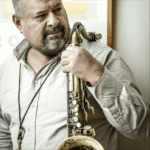Orchestra Without Borders Boston
Luca Antonucci, music director
presents
borderlines east-west
with
Hannah Shanefield, soprano
Jonathan Fagan, jazz piano
Michael Rosen, jazz saxophone
Music for chamber strings from around the world
paired with original jazz compositions
Saturday, May 18, 2024, 7:30 pm
First Unitarian Universalist Society in Newton
1326 Washington St.
Newton, MA 02465
Suggested donation: $20
to benefit the work of
Communities Without Borders
- Nafahat Hijaz by Mahdi AlMahdi, a piece based on a Levantine traditional/folk-musical scale, called Hijaz
- Five Afro-Cuban Songs by Odaline de la Martinez, based on five traditional poems from Cuba that highlight the Diasporic community and its history
- A new piece by emerging Afghan composer Arson Fahim based on Afghan folk songs
- Sonata da Chiesa by Adolphus Hailstork, a work that blends the African-American experience with the traditions of Baroque church music
Luca Antonucci is

Boston-based soprano Hannah Shanefield



Michael Rosen is






